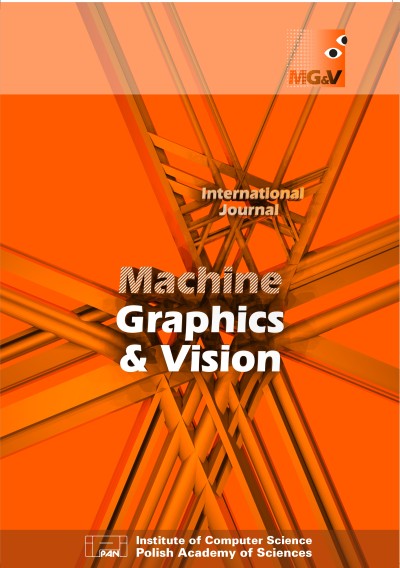Main Article Content
Article Details
Watson D. F.: Computing the n-dimensional Delaunay tessellation with application to Voronoi polytopes, The Computer Journal, 2:167-172, 1981. (Crossref)
Fortune S.: A sweepline algorithm for Voronoi diagrams, SCG’86: Proceedings of the second annual symposium on Computational geometry, p. 313-322, 1986. (Crossref)
Aurenhammer F.: Power Diagrams: Properties, Algorithms and Applications, SIAM Journal on Computing, 16:78-96, 1986. (Crossref)
Edelsbrunner H., Shah N. R.: Incremental Topological Flipping Works for Regular Triangulations, ACM Annual Symposium on Computational Geometry, 8:43-52, 1992. (Crossref)
Eppstein D.: Finding the k-Shortest Paths, 35th Annual Symposium on Foundations of Computer Science, p. 154-165, 1994.
Stentz A.: Optimal and Efficient Path Planning for Partially-Known Environments, Proceedings IEEE International Conference on Robotics and Automation, San Diego, California, USA, p. 3310-3317, 1994.
Barber C. B., Dobkin D. P., Huhdanpaa H.: The quickhull algorithm for convex hulls, ACM Trans. Math. Softw., 22:469-483, 1996. (Crossref)
Goodman J. E., O’Rourke J.: Handbook of Discrete and Computational Geometry, CRC Press LLC, 1997.
Skiena S. S.: The Algorithm Design Manual, Springer-Verlag, New York, 1997.
Cignoni P., Montani C., Scopigno R. : DeWall: A fast divide and conquer Delaunay triangulation algorithm in Ed, Computer-Aided Design, 30:333-341, 1997. (Crossref)
Bandi S., Thalmann D.: Space Discretization for Efficient Human Navigation, Computer Graphics Forum, 17(3):195-206, 1998. (Crossref)
Dor D., Halperin S., Zwick U.: All-Pairs Almost Shortest Paths, SIAM Journal on Computing, 29(5):1740-1759, 2000. (Crossref)
Shewchuk J. R.: Sweep algorithms for constructing higher-dimensional constrained Delaunay triangulations, SCG ’00: Proceedings of the sixteenth annual symposium on Computational geometry, p. 350-359, 2000. (Crossref)
Arikan O., Chenney S., Forsyth D. A.: Efficient Multi-Agent Path Planning, Computer Animation and Simulation, p. 151-162, 2001. (Crossref)
Champandard A. J.: Path-Planning from Start to Finish (Internet source: http://www.ai-depot.com/BotNavigation), 2001
Geraerts R., Overmars M. H.: A Comparative Study of Probabilistic Roadmap Planners, Proc. Workshop on the Algorithmic Foundations of Robotics (WAFR’02), p. 43-57, 2002. (Crossref)
Vigo M., Pla N., Cotrina J.: Regular Triangulations of Dynamics Sets of Points. Computer Aided Geometric Design 19:127-149, 2002. (Crossref)
Devillers O., Teillaud M.: Perturbations and Vertex Removal in a 3D Delaunay Triangulation. Proceedings 14th ACM-SIAM Symposium on Discrete Algorithms, Baltimore, MD, USA, p. 313-319, 2003.
Shewchuk J.R.: Stabbing Delaunay tetrahedralizations, Discrete Comput. Geom., 32:343, 2004. (Crossref)
Wallgrün J. O.: Autonomous Construction of Hierarchical Voronoi-Based Route Graph Representations, Spatial Cognition IV. Reasoning, Action, and Interaction, 3343:413-433, 2005. (Crossref)
Beyer T., Schaller G., Deutsch A., Meyer-Hermann M.: Parallel dynamic and kinetic regular triangulation in three dimensions, Computer Physics Communications, 172:86-108, 2005. (Crossref)
Ledoux H., Gold C.M., Baciu G.: Flipping to Robustly Delete a Vertex in a Delaunay Tetrahedralization. ICCSA (1):737-747, 2005. (Crossref)
Brož P., Kolingerová I., Zitka P., Apu R. A., Gavrilova M.: Path planning in dynamic environment using an adaptive mesh, Proceedings of the SCCG, p. 172-178, 2007 (Crossref)
Brož P.: Exact and heuristic path planning methods for a virtual environment, Proceedings of the CESCG, 2007
Medek P., Beneš P., Sochor J.: Computation of tunnels in protein molecules using Delaunay triangulation. Proceedings of the WSCG, 2007.
Zemek M., Kolingerová I.: Hybrid algorithm for deletion of a point in regular and Delaunay triangulation. Spring Conference on Computer Graphics, Budmerice, Slovakia, p. 149-2156, 2009. (Crossref)
Zemek M.: Regular triangulation in 3D and its applications. Technical report, University of West Bohemia, Faculty of Applied Sciences, Department of Computer Science and Engineering, (Internet source: https://www.kiv.zcu.cz/site/documents/verejne/vyzkum/publikace/technicke-zpravy/2009/tr-2009-03.pdf), 2009.





